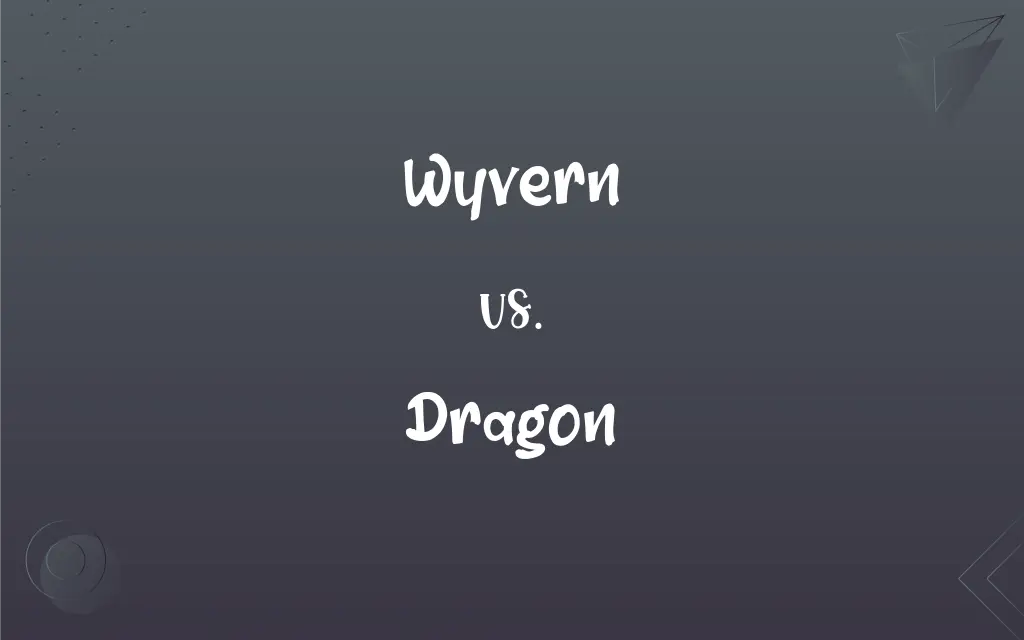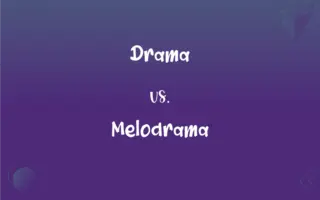Wyvern vs. Dragon: What's the Difference?
Edited by Aimie Carlson || By Janet White || Published on November 30, 2023
Wyverns are mythical creatures with two legs and wings, often depicted in heraldry, while dragons are legendary beings with four legs, wings, and the ability to breathe fire in many cultures.

Key Differences
A wyvern is a mythical creature characterized by its two-legged and winged form, often appearing in European heraldry and folklore. Dragons, in contrast, are depicted in various mythologies worldwide as powerful, four-legged creatures, often with the ability to breathe fire.
Wyverns are typically smaller and less powerful than dragons, and they are often portrayed as less intelligent. Dragons, on the other hand, are frequently depicted as wise, ancient, and incredibly strong, embodying power and might.
In terms of symbolism, wyverns are often associated with war and destruction in medieval heraldry, whereas dragons symbolize strength, wisdom, and sometimes greed, especially in Eastern cultures.
The wyvern's physical appearance, with its serpentine body and two legs, distinguishes it from the more robust and quadrupedal dragon, which is often larger and more imposing in myths and legends.
In popular culture, wyverns have gained visibility in fantasy literature and games, typically as lesser creatures than dragons, which are often central figures in fantasy stories, embodying majesty and magical power.
ADVERTISEMENT
Comparison Chart
Legs
Two-legged
Four-legged
Size and Strength
Typically smaller and less powerful
Larger and more powerful
Symbolism
War, destruction
Power, wisdom, sometimes greed
Physical Appearance
Serpentine body, winged
Robust body, often with wings
Cultural Depiction
European heraldry and folklore
Global mythologies, various depictions
ADVERTISEMENT
Wyvern and Dragon Definitions
Wyvern
A mythical creature with two legs and wings.
The castle's crest featured a wyvern, symbolizing strength.
Dragon
A mythical, often fire-breathing creature with four legs.
The dragon guarded the treasure with fiery breath.
Wyvern
Often depicted in heraldic emblems and coats of arms.
The family's banner bore a red wyvern, a sign of their heritage.
Dragon
A symbol of power and wisdom in many cultures.
In the festival, the dragon represented good fortune and strength.
Wyvern
A dragon-like being in European folklore.
In the tale, a brave knight fought a fierce wyvern.
Dragon
A legendary creature of varied global depictions.
Eastern dragons are often seen as benevolent, unlike their Western counterparts.
Wyvern
A creature less powerful than a dragon.
The wyvern, though formidable, was not as feared as the dragon.
Dragon
A central figure in fantasy stories and myths.
The ancient dragon in the story held the secrets of the universe.
Wyvern
A symbol of war and destruction in medieval times.
The wyvern on the battlefield flag was an intimidating sight.
Dragon
A creature embodying majesty and magical power.
The dragon's majestic presence was revered by all in the kingdom.
Wyvern
A two-legged dragon having wings and a barbed tail.
Dragon
See Draco2.
Wyvern
A draconian creature possessing wings, only two legs and usually a barbed tail.
Dragon
A mythical monster traditionally represented as a gigantic reptile having a long tail, sharp claws, scaly skin, and often wings.
Wyvern
Same as Wiver.
Dragon
Any of various lizards, such as the Komodo dragon or the flying lizard.
Wyvern
A fire-breathing dragon used in medieval heraldry; had the head of a dragon and the tail of a snake and a body with wings and two legs
FAQs
Are wyverns fire-breathing like dragons?
Some depictions include fire-breathing wyverns, but it's more common in dragons.
How does a dragon differ from a wyvern?
Dragons are typically four-legged, larger, and more powerful than two-legged wyverns.
What do dragons represent?
Dragons symbolize strength, wisdom, and sometimes greed or malevolence.
Do all cultures have dragons in their mythology?
Many, but not all, cultures have some form of dragon in their mythology.
How are Eastern and Western dragons different?
Eastern dragons are often seen as wise and benevolent, while Western dragons are typically depicted as malevolent and hoarding treasure.
Is the wyvern a type of dragon?
The wyvern is often considered a type of dragon, but with distinct characteristics.
What is a wyvern?
A wyvern is a mythical creature with two legs and wings, often seen in heraldry.
What do wyverns symbolize?
Wyverns often symbolize war and destruction, especially in medieval European contexts.
Are dragons considered intelligent in myths?
Dragons are often portrayed as highly intelligent, sometimes even wise, in myths.
Do dragons always have wings?
Most dragon myths depict them with wings, but variations exist across cultures.
Can wyverns be benevolent?
While less common, some stories do depict wyverns as benevolent or neutral.
Do wyverns play a major role in folklore?
Wyverns are more often minor creatures compared to the central role of dragons.
Are wyverns always portrayed as evil?
Not always; their depiction varies, though they are often seen as fearsome.
Are wyverns depicted in modern fantasy?
Yes, wyverns appear in modern fantasy literature and games, often as lesser dragons.
Are wyverns featured in heraldry?
Yes, wyverns are common in European heraldry, often representing warriors or protectors.
Can wyverns speak in myths?
In some stories, wyverns, like dragons, can speak or possess magical abilities.
Is the dragon a universal symbol?
The dragon is one of the most universal and enduring mythical creatures across various cultures.
Do dragons have special powers in mythology?
Many dragons in mythology have special powers, such as breathing fire or controlling weather.
Do dragons have a common appearance?
While varying greatly, dragons typically share traits like reptilian features and immense size.
How are dragons used in literature?
Dragons in literature are used for various themes, from representing ultimate evil to embodying wisdom.
About Author
Written by
Janet WhiteJanet White has been an esteemed writer and blogger for Difference Wiki. Holding a Master's degree in Science and Medical Journalism from the prestigious Boston University, she has consistently demonstrated her expertise and passion for her field. When she's not immersed in her work, Janet relishes her time exercising, delving into a good book, and cherishing moments with friends and family.
Edited by
Aimie CarlsonAimie Carlson, holding a master's degree in English literature, is a fervent English language enthusiast. She lends her writing talents to Difference Wiki, a prominent website that specializes in comparisons, offering readers insightful analyses that both captivate and inform.































































